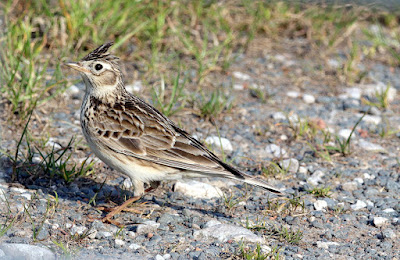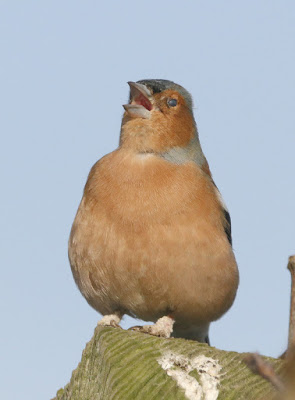A week after our return from holiday and the necessary catch-ups completed it was time to check out a few local places.
I started at Cockerham Quarry where the Sand Martin colony should be well underway. It was - many dozens of holes and a hive of activity as 140 or more Sand Martins flew back and forth to their excavations. The martins were still collecting dried grasses from the quarry floor for lining their chambers situated mostly at the very top of the quarry face. I saw no early fledglings, just adults.
Sand Martin
The quarry face is unstable and the entrance holes very high which puts it into the realms of a mountaineering expedition rather than a modest mist netting session. We plan another visit in early/mid June and when there are youngsters about and when the increase in overall numbers may present catching opportunities at lower levels.
There were a few Sand Martins over the water at Conder Green, just a flap and a glide from the quarry. A few Swallows too, but sadly, no sign of Swifts. Each year sees a decline in Swallows and Swifts all around us but the success of the nearby Sand Martin colony has increased their numbers in the local area.
Waders and wildfowl now consist of those either likely too or in the actual process of breeding, and counts of 10 Oystercatcher, 6 Redshank, 4 Avocet, 2 Little Ringed Plover, 10 Tufted Duck and 6 Shelduck. The 4 Little Egrets are not nesting but a pair or two of Common Tern seemed to be among the six individuals that I saw argue and display over the islands and nesting platforms.
Shelduck - male
Shelduck - female
Avocets have at least two feeding methods. In clear water, they feed by sight by picking prey from the surface of water or mud. In poor visibility and when locating prey from within the sediments, they forage by touch, sweeping the long, up-curved bill from side to side through water or loose sediment to locate hidden prey.
In deeper water they swim readily and buoyantly, up-ending like a duck to reach food below the surface.
Avocet
Avocet
Avocet
Passerines along the hedgerow were not many - 3 Goldfinch, plus singing singles of Common Whitethroat, Reed Bunting and Blackcap. Just today saw the first juvenile Goldfinches appear in my back garden, fluttering their wings and begging to be fed by accompanying adults.
Along Jeremy Lane I found the only Reed Warbler of the morning, singing from the roadside ditch but with none in the usual spots in the dense reeds of Conder Green. As ever, it is not necessarily the species and/or numbers seen. It is those birds that are absent which provide clues about the ups but mostly downs of bird populations.
Further exploration of the lanes produced good numbers of Sedge Warbler, twelve or more singing along the ditches of Moss Lane, Jeremy Lane and Cockersands. In contrast, Common Whitethroats were few and far between with just three songsters along the same circuit, although I did happen upon a Lesser Whitethroat.
As the name suggests, this warbler is smaller than its cousin the Common Whitethroat. It has dark cheek feathers which contrast with the pale throat and can give it a 'masked' look. Lesser Whitethroats can be skulking and hard to see, often only noticed when they give their very distinctive harsh, rattling song.
In contrast, the song of a Common Whitethroat is fast, scratchy and scolding, often delivered from a conspicuous song post for all to see and hear. Today it was a blossoming hawthorn bush.
Lesser Whitethroat
Common Whitethroat
Common Whitethroat
I saw good numbers of Lapwings, Brown Hares and Stock Doves in the cut meadows near Cockersands where I chanced upon a young Lapwing. Just the right size for a "D" ring - the first and probably last of the year.
Brown Hare
Lapwing chick
Back soon with more news and views.
In the meantime, linking with Wild Bird Wednesday, Anni's Birding and Eileen's Saturday Post.
In the meantime, linking with Wild Bird Wednesday, Anni's Birding and Eileen's Saturday Post.












































































